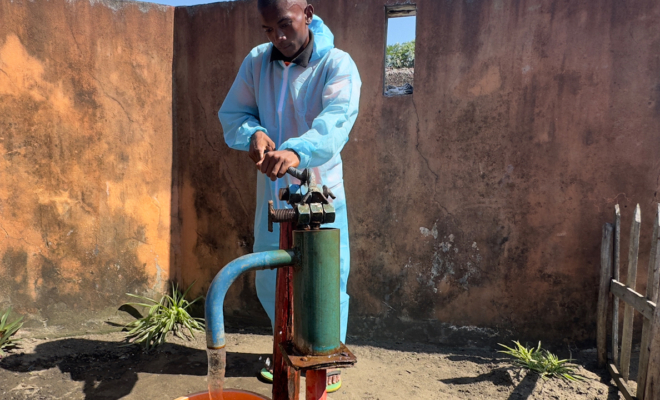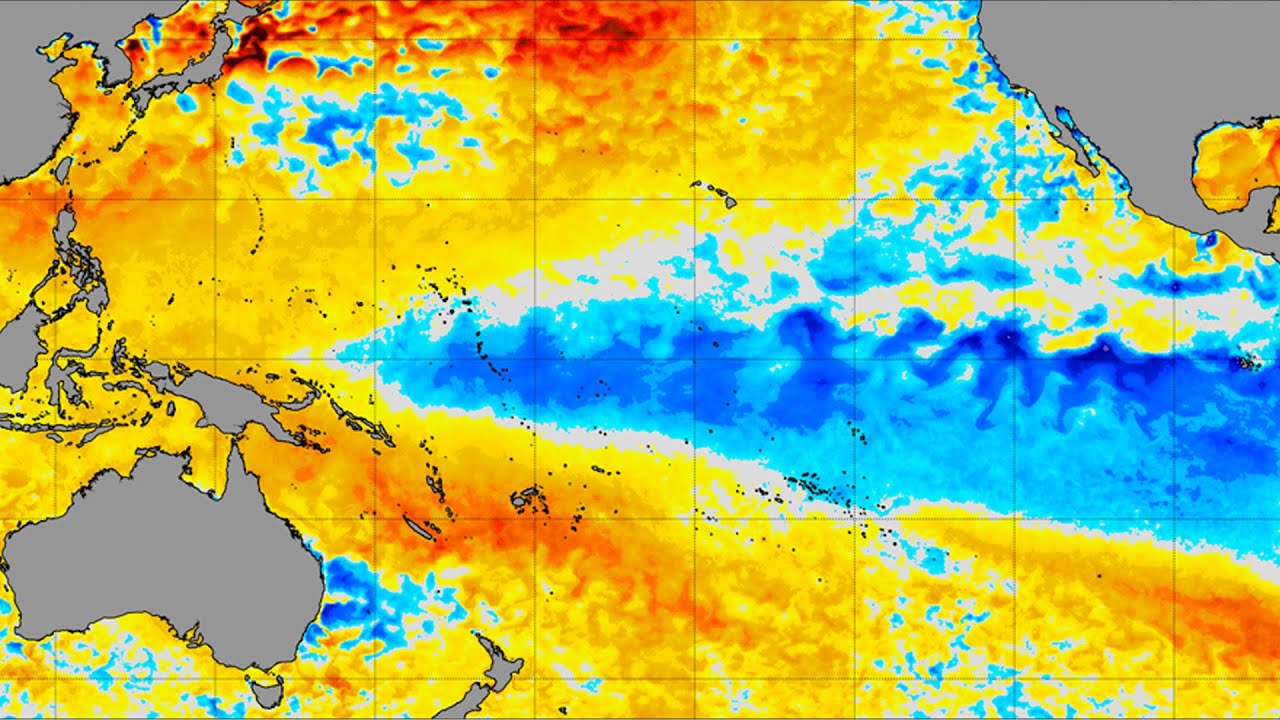
This June, the temperature of the North Atlantic reached a record that has perplexed scientists: almost 1.1 ºC above the average of the last 40 years. Moreover, across the Earth, sea surface temperatures are reaching values unseen since records have been kept.
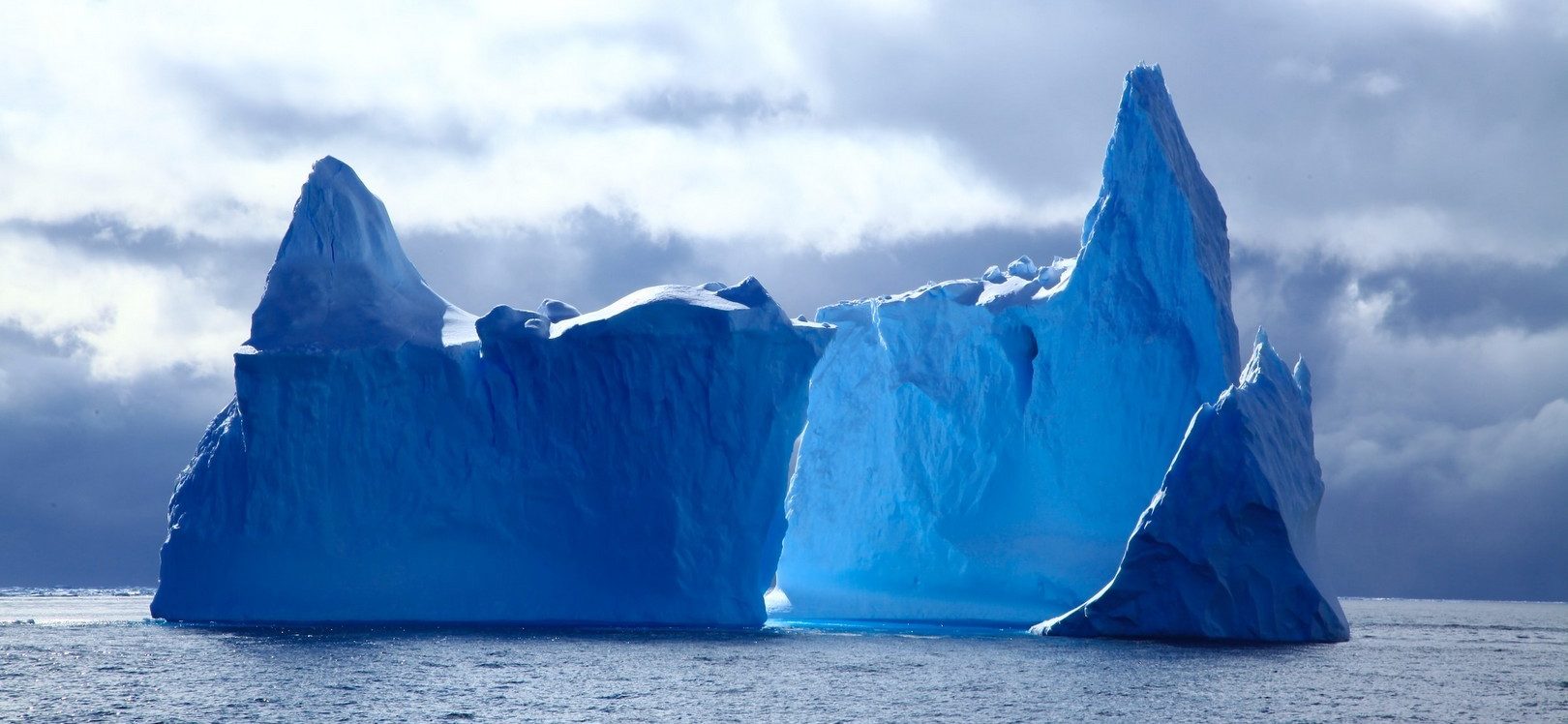
The oceans of the northern hemisphere are experiencing a remarkable increase in temperature danting.© zhu -unsplash
This increase is nothing new. The Intergovernmental Panel on Climate Change (IPCC) reported two years ago that the global average sea surface temperature increased globally by about 0.6°C from 1900 to 2017, and all projections point to this trend continuing.
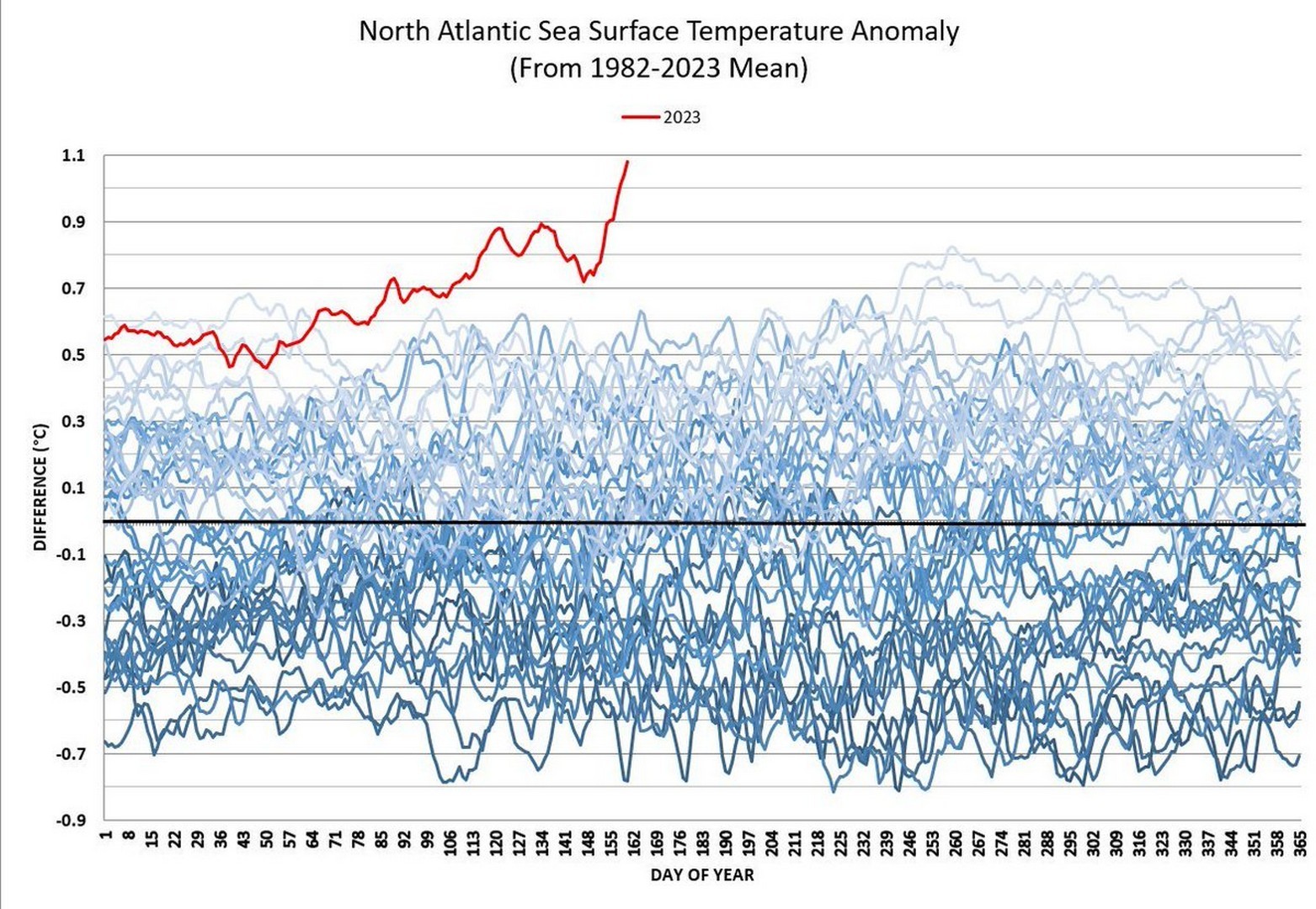
Chart showing the increase in the average surface temperature of the North Atlantic. In red, the temperature for this year, 2023; in blue, the temperatures from 1982 to 2022. Note the significant increase in early June. © CERES data edited by Prof. Eliot Jacobson.
This year, the situation coincides with the El Niño episode, a natural phenomenon that begins with an increase in water surface temperature in the central and eastern tropical Pacific. El Niño occurs in cycles separated by about 2 to 7 years, with episodes lasting 9 to 12 months. The latest data from the World Meteorological Organization indicate that El Niño will likely modify the global climate from the second half of 2023.
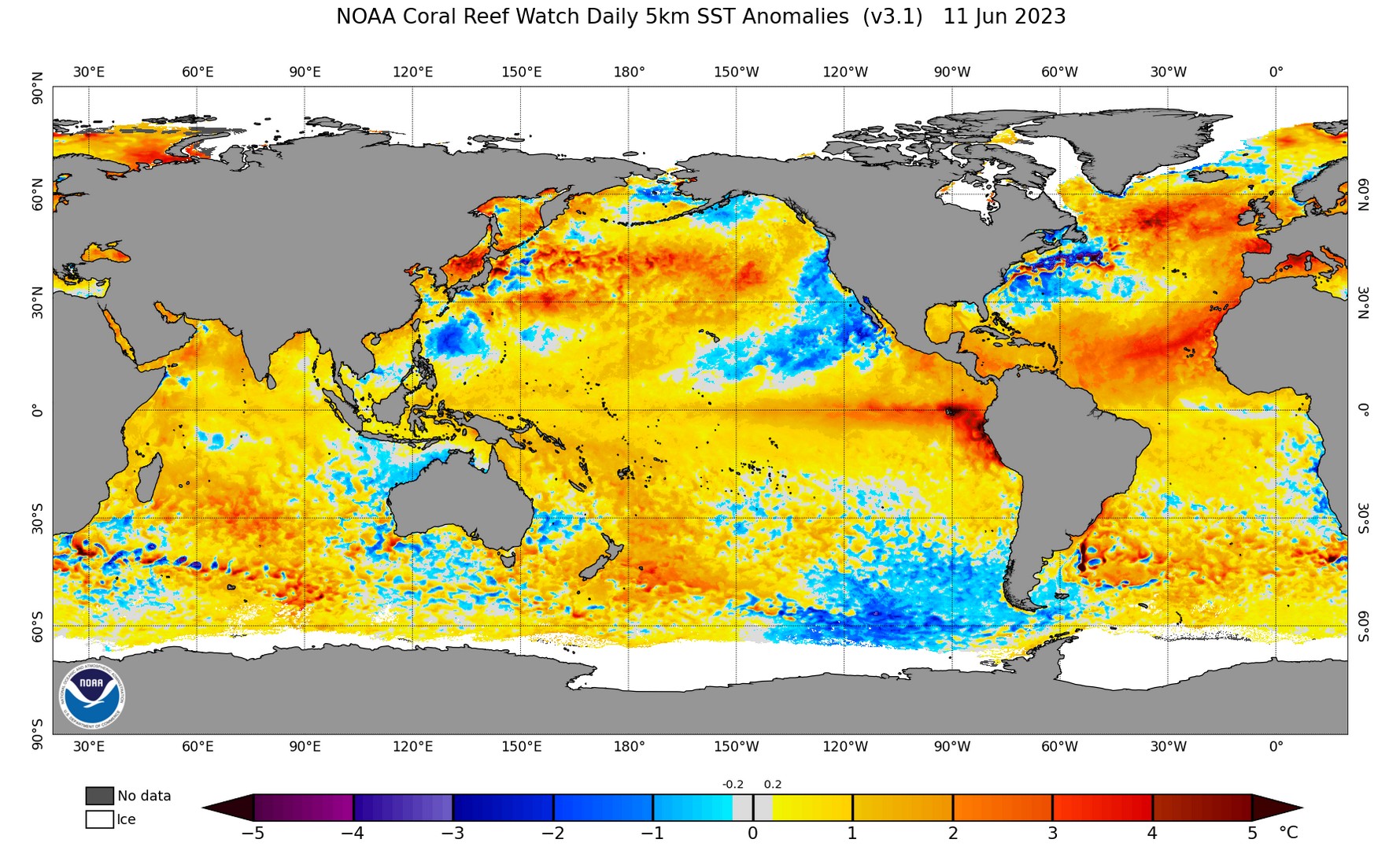
This map shows the water temperature anomalies on June 11, 2023. The red areas in the North Atlantic and North Pacific are clearly visible, as well as the tropical MDR. Also visible is the warming due to El Niño along the South American Pacific coast. © NOAA Coral Reef Watch Daily
The increasing anomalies are also occurring significantly in the area of the Atlantic where 85% of all major hurricanes and 60% of all powerful tropical storms (the ones given a name) are generated. This is the so-called Atlantic Main Development Region (MDR), which stretches from the coast of Africa to Central America, between latitudes 10°N and 20°N. There, the sea surface has reached an average temperature of 28 ˚C, breaking the record set in 2005. That year saw the second most active hurricane season ever registered.
What are the causes?
Scientists are analyzing the possible causes of this pronounced thermal phenomenon. The obvious one is atmospheric warming, which continues to increase. It is known that the oceans absorb about 89% of the excess heat from the air above them, and this causes the temperature to rise and the thermal expansion of their mass, an effect that we have noticed for years in the rise in sea level.
A meteorological cause also seems more than likely. The Azores anticyclone and the associated trade winds have weakened considerably since the end of May, which facilitates the warming of the water mass beneath them.
Another hypothesis being bandied about may surprise many: the decrease in sulfate aerosols in high sea traffic density areas. As of January 2020, the International Maritime Organization lowered fuel sulfur content for merchant ships from 3.50% to 0.50%. This was done to reduce pollutant emissions of sulfur dioxide (SO2) and the sulfate aerosols that this gas generates in the atmosphere. These aerosols increase the reflection of part of the solar radiation, thermally “protecting” the sea surface, which heats up less locally or regionally. The coincidence of major shipping lanes in the North Atlantic and North Pacific with the areas where warming occurs indicates a correlation.
In this regard, it is also considered that the decrease in Saharan dust transported over the Atlantic may have contributed to the temperature increase, as dust particles block solar radiation and trap heat. This year a reduction in these particles has been detected, which, together with the weakening of the trade winds that transport them, may have contributed significantly to the warming of the MDR.
What could be the consequences?
Scientists do not draw deterministic conclusions about what may happen after this year’s exceptional warming. The warming of the water in the MDR is a factor that points to an increase in the number and intensity of hurricanes in this year’s season (from June to November). However, experts from the US National Oceanic and Atmospheric Administration (NOAA) explain that the El Niño effect may reduce cyclonic activity in the area, as has been observed before, although the possibility of it being intense is still high.
Warming may worsen some of the “points of no return” critical for the planet’s future. One of the most troubling is the progressive deterioration of sea ice, which, at a global level, is currently the lowest in the entire historical record. The loss of polar ice, another primary climate regulator, is of particular concern because of the feared “positive feedback” effect: the increase in atmospheric temperature causes melting, which in turn causes the temperature to rise. This is because the exposed liquid water surface absorbs more energy from solar radiation and therefore warms up more than ice or snow, which reflect most of this radiation, thus accelerating global warming.
The effects on North Atlantic currents, detected in recent years by oceanographers, are another critical factor. The so-called Atlantic Meridional Overturning Circulation, more commonly known as AMOC, is being altered as currents weaken, mainly due to the melting of Greenland. This factor raises fears of a tipping point in the water cycle with irreversible negative consequences, and water warming is a variable that tends to accelerate the process.
Beyond the water cycle
Warming seawater can increase its acidification because carbon dioxide (CO2) is more soluble in water at higher temperatures and the reaction with this gas forms carbonic acid. The average acidity of the ocean surface has remained stable for millions of years but has increased by about 26% in the last 150 years.
Acidification wreaks havoc on species that produce calcium carbonate shells or skeletons, with corals bearing the brunt. Tropical coral reefs are ecosystems that occupy only 0.1% of the ocean floor but are home to up to nine million species. Over the next 20 years, if they continue to degrade, the livelihoods of 500 million people, the coastal protection of their homes, and their incomes will be in serious jeopardy.

So far, the oceans have protected us from the worst effects of climate change, but there is significant uncertainty about their ability to continue to do so in the future. © karson- unsplash
So far, the oceans have protected us from the worst effects of climate change, but there is significant uncertainty about their ability to continue to do so in the future. The warming of the ocean makes us realize that we are investing too little in learning about it. We must not forget that there is only one water on the planet.




